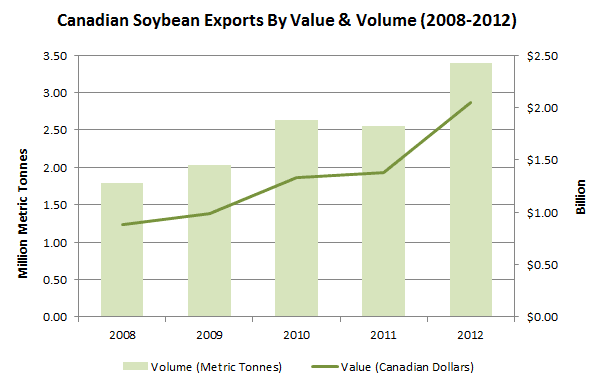Soybean export markets
TAKING THE RIGHT OPPORTUNITIES
soybean export markets are increasingly important to Canada. We export between 50 and 70 percent of our total production each year, and that amount is going up. Understanding the changes in global demand helps Grain Farmers of Ontario focus its market development efforts and trade missions, such as the recent trip to Asia (detailed on page 12). Industry and government partners help to provide key insights into these markets also.
recent statistics
“Between 2008 and 2012, exports by volume increased by about 90 percent, and exports as a percentage of total production has continued to rise,” says Ken Hester. Hester is a sector specialist with Agriculture and Agri-Food Canada (AAFC), who has recently done some calculations on Canadian export markets using data from Statistics Canada.
Hester notes that Asia now represents our largest export region, at about 43 percent by volume of total exports in 2012. Exports to Asia increased about 97 percent between 2008 and 2012, with a significant jump in 2012.
“The Netherlands overtook Japan for the first time in more than 10 years as the most valuable export market by both dollar value and volume in 2010,” Hester observes. “However, in 2012, China became the single largest market, with about 24 percent of total exports by volume, with Japan at 11 percent and the Netherlands at 17 percent. Within the European Union, the Netherlands was followed by Belgium, Germany and Italy.”
When comparing export markets on a price received per metric tonne (pmt) basis, it is clear that Asian markets provide higher value than markets elsewhere, Hester explains. “Asian countries provide an average of $634.67 pmt ($683.04 if you exclude China), with Japan, South Korea, Thailand and Taiwan all above $700 pmt,” he says. “Compare that to the US at $567.83, the EU at $586.25 and Middle Eastern/North African markets at $571.42.” This is likely attributable, in Hester’s view, to higher-value products such as non-GM IP food grade soybeans being a larger portion of total exports in Asia versus the situation in other markets.
TABLE: STATISTICS CANADA DATA ANALYZED BY KEN HESTER, AAFC.

opportunities going forward
The explanation for why certain Canadian soybean export markets will grow over others comes down to a combination of quality standards, identity preservation demand and total value proposition, notes Dave Buttenham, Secretary-Manager, Canadian Soybean Exporters’ Association (CSEA).
Hester says opportunities for Canadian growers related to speciality production, such as non-GM soybeans, will continue to remain strong in markets such as Europe and Asia, given well-established preferences from many segments of the value chain.
“However, it’s important to understand that in specialty segments, Canada has primary and secondary markets that need to be served,” he says. “Japan continues to be one of Canada’s primary markets for specialty products because of the years invested in growing the market, tailoring soybeans that meet the specific needs and quality characteristics of different end-users.”
Secondary markets might include opportunities in South East Asian markets and European markets looking for various specialty types for food or feed uses.
“It’s also important to focus on product attributes where Canada has an advantage, such as continuing with a strategy of differentiation, selling traceability strengths and other quality characteristics where higher value can be derived,” Hester notes. “The EU countries, like many other markets, are increasingly looking to sources such as Canada that can meet their quality, safety and traceability needs.”
He says this is largely due to our significant investments made over the past 30 years in terms of research, production practices and grain handling and processing infrastructure. “It’s important that Canada continues to maintain and build relationships with key export markets, communicating the advantages of buying high-quality food grade soybeans that meet the needs of end-users,” Hester notes. “As Canadian soybean exports grow, it’s important to continue to undertake market development programs to promote the benefit of buying specialty Canadian soybeans, building on the Canadian brand for quality and reliability.”
promoting canada
The Canadian Soybean Council (CSC), a coalition among Canada’s major soybean growing provinces established in 2005, holds a number of market development activities each year in collaboration with CSEA, AAFC and trade commissioners from various countries. “Each year, target countries are selected for incoming and outgoing programs,” says Nicole Mackellar, CSC Program Coordinator and Grain Farmers of Ontario Market Development Coordinator. “CSC outgoing programs visit Japan each year, as Japan is Canada’s largest market for food grade soybeans and it is critical to maintain customer relationships that have taken several years to develop.”
Other countries are selected for programs based on a number of factors; including Statistics Canada soybean export numbers, export trends, soybean market overviews on each country provided by AAFC and trade commissioners, and critical input from the CSEA.
“The CSC also does a lot of research to better understand what is happening in various markets,” Mackellar explains. “We also keep a close eye on the production trends in competing countries such as the US, Brazil, Argentina, Paraguay and China.” She notes that while the quest to expand markets is important, it must be done wisely to make sure production levels can meet growing needs. “It is, indeed, sometimes challenging to match supply and demand for specialty products; but growers and exporters are working together to share information about market opportunities for IP soybeans.” •







